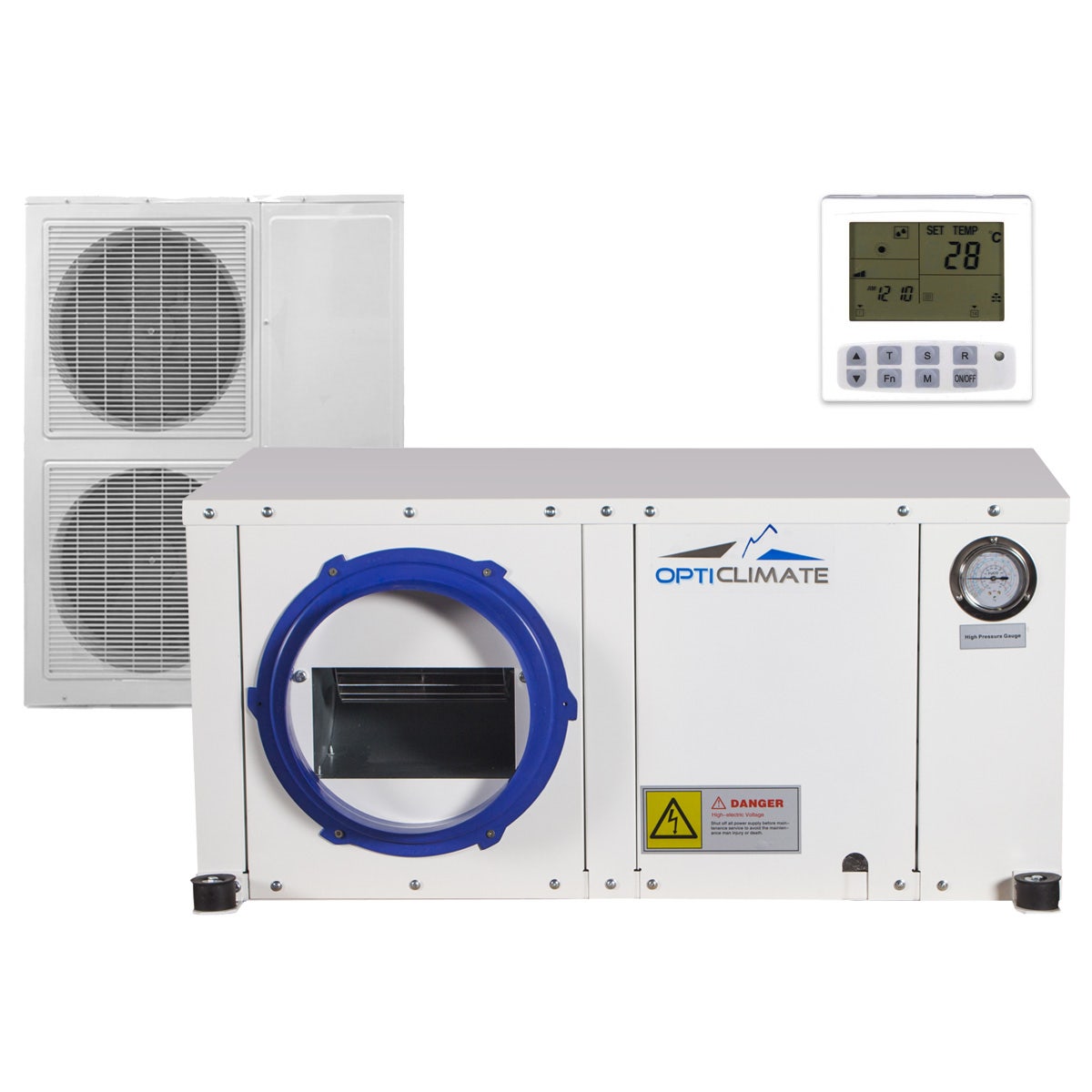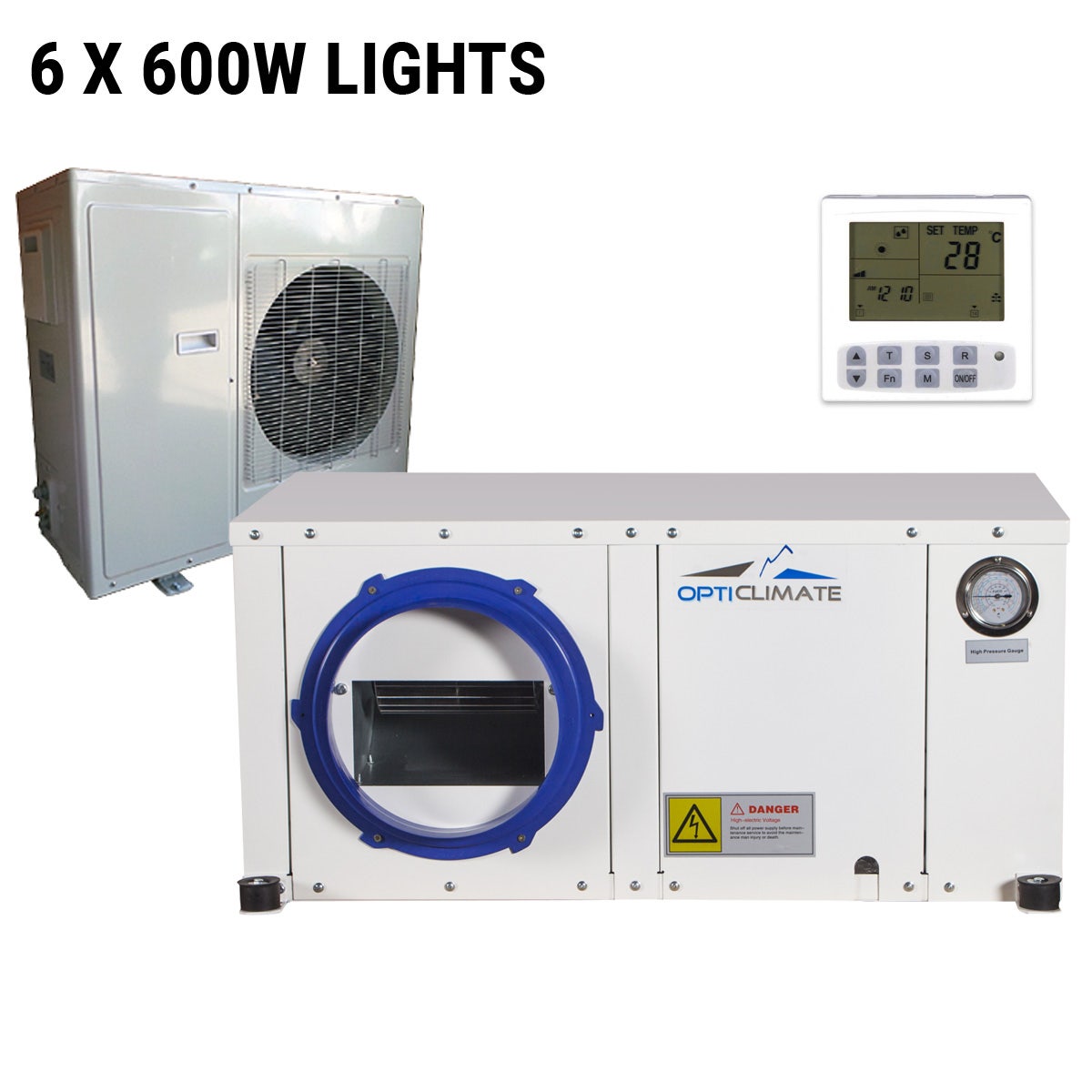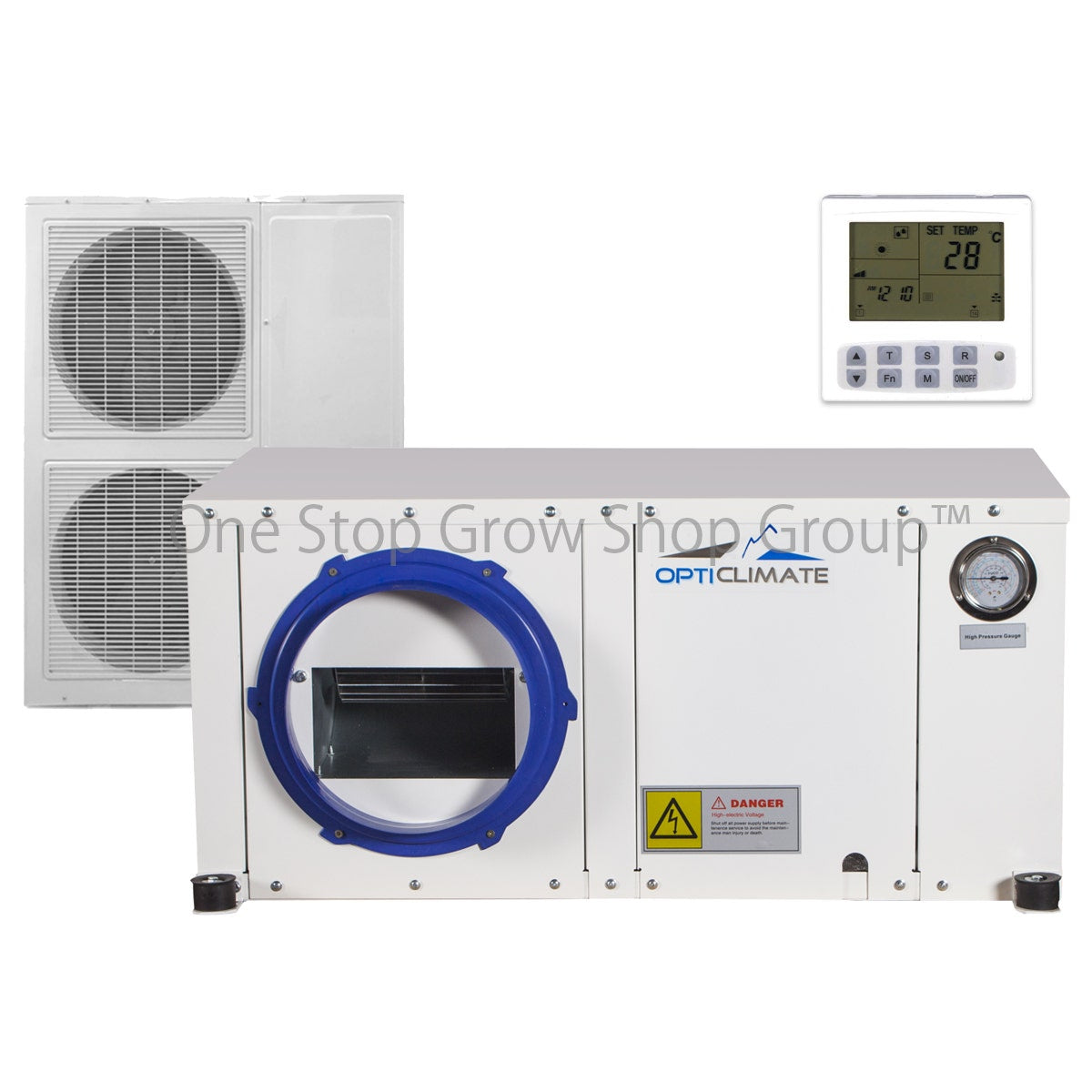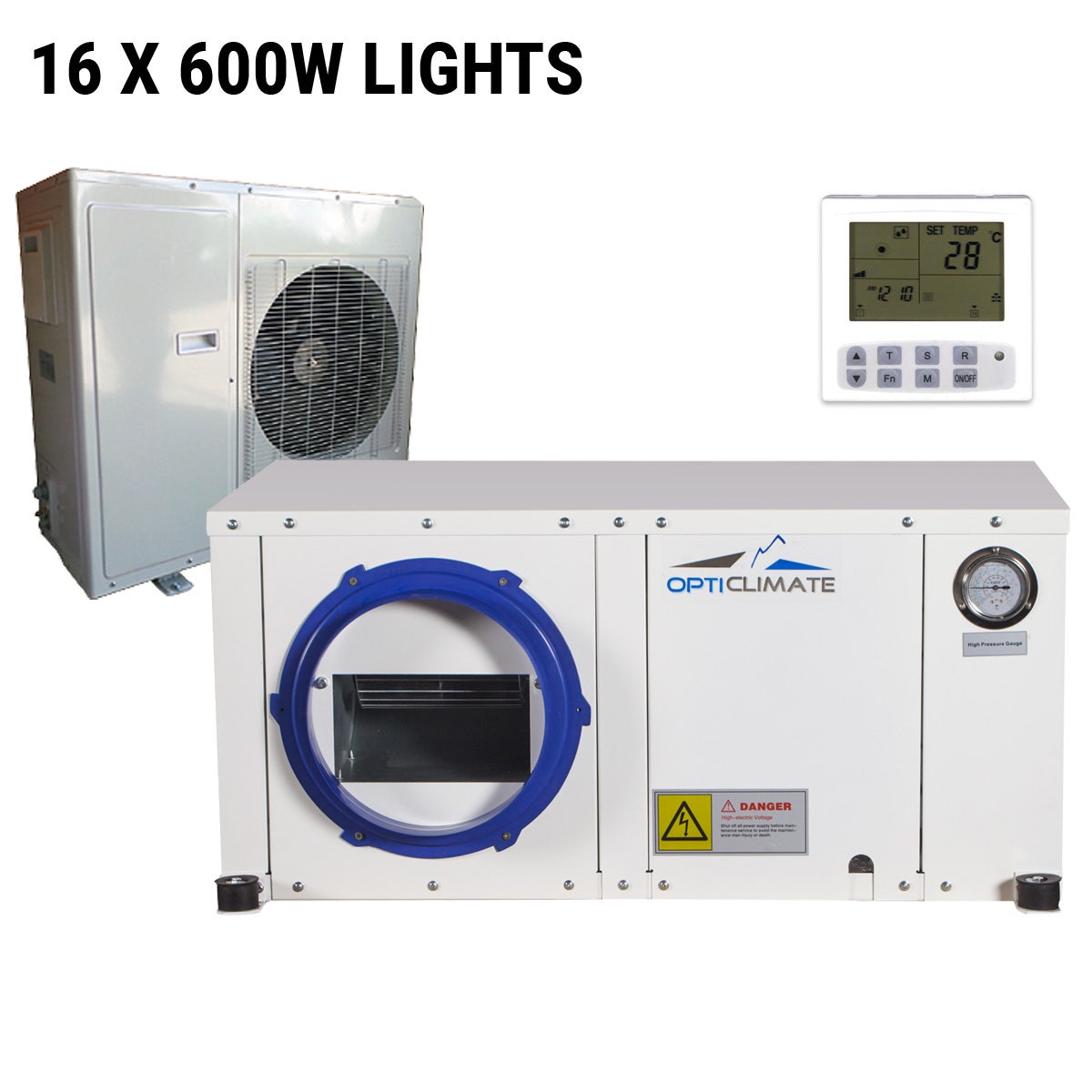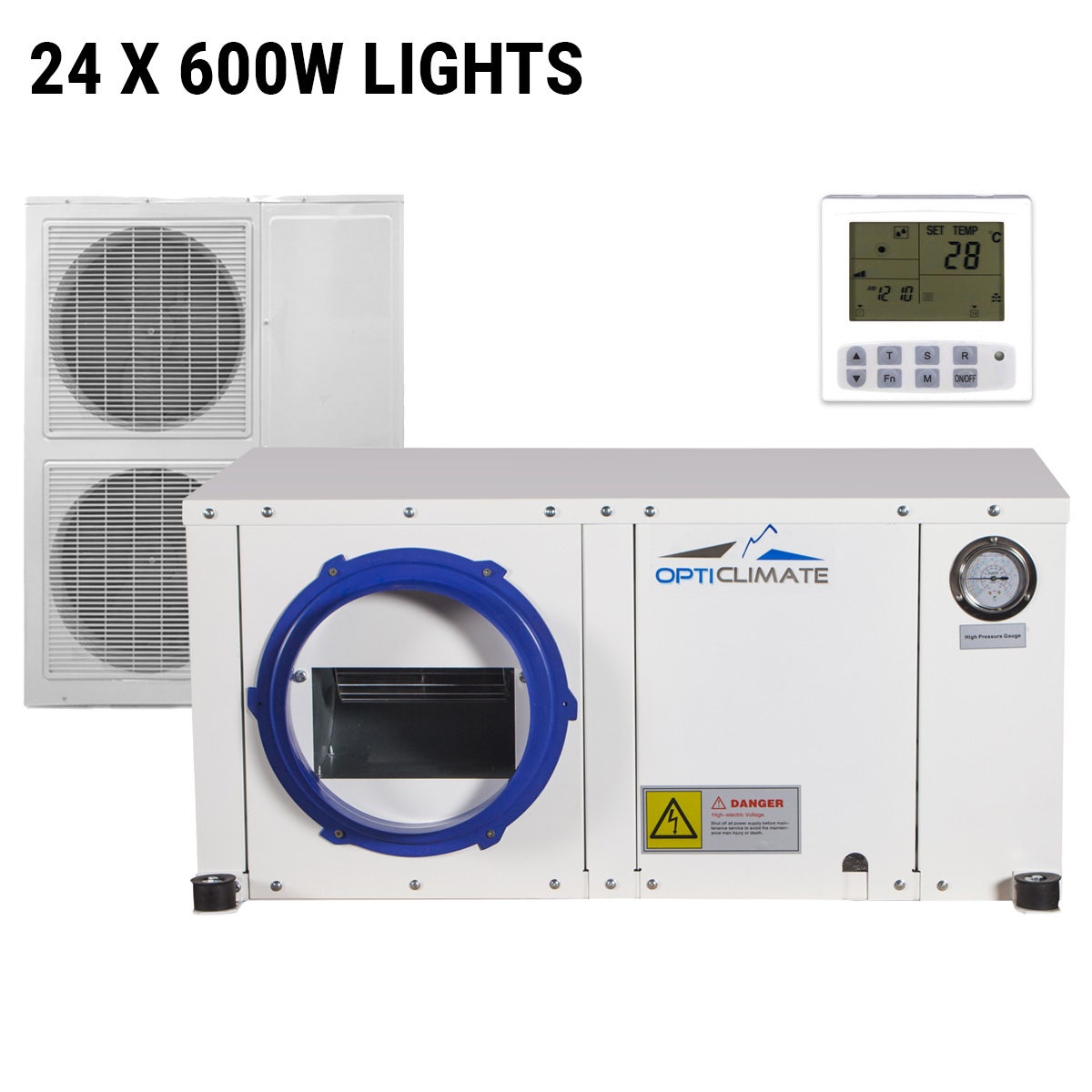Opticlimate - The Ultimate Growroom Air Conditioner
Part-Comissioning is available on the Opticlimate Splits - please note though, once these are hooked up, the pipes cannot be removed and technical support doesn't cover split-units.
The Opticlimate Pro 3 Split gives you the ability to grow in perfect conditions all year round. It's a complete climate control air-conditioning solution that treats the air in your grow room or tent to ensure that temperature and humidity levels are always kept within ideal ranges even during the hottest months of summer, thanks to its built-in heating, cooling and filtering system. Available in 4 sizes, which all cater for every different size of grow room, check out the guide below or speak to our experts on 01782 749 955 for more help on choosing the ideal system for you.
Opticlimates remove the need for a large extraction system. Operating much more quietly, Split Opticlimates have an outdoor unit, connected to the main unit by a length of pipe. Working with coolant gasses rather than water cuts down on water consumption, there's no expert needed for installation, the units come pre-gassed, install is something you can do at home with guidance from our in-house experts.
How the Opticlimate Pro 3 Split Works
The Opticlimate provides air conditioning for grow rooms by maintaining temperature and humidity levels within optimal ranges during both day and night cycles, regardless of outside temperatures. Inside the unit are 1500w ceramic heaters and a air cooling system. Air is drawn through the Opticlimate's carbon filter panel (at the back of the unit) via a squirrel cage fan. The air is then treated to match user-defined specifications and expelled through the outlet point (at the front of the unit), where it can then be ducted towards the top of the plant canopy. This process maintains a climate that's tailored to your exact needs. You'll then have complete peace-of-mind that your grow room is always operating optimally, with happier, healthier plants and huge potential increases in yields.
The air conditioning system relies on a supply of air brought in through the external unit (mounted on a external wall) which is then connected to the internal unit (inside the grow space) via the supplied hose. Installation is relatively straight forward, but the job should be performed by somebody with the appropriate skills.
There is another outlet on the Opticlimate for water produced by the dehumidification process, but in this case, we recommend using it to fill your reservoir tank. A float-valve activated lifting pump is available separately which will redistribute this water to other areas if required.
The Opticlimate comes with a tethered controller unit which is used to program ideal daytime and night-time temperature and humidity levels. 'Preheat' and 'slow cool-down' functions can be set up to gradually ease plants into day and night cycles. This is particularly useful when moving from night (18°C) to day (25°C). As lights switch on, it takes a little while for the temperature of plant matter to reach an equilibrium with the room. During this period, the cool outer edges of fruits and leaves contact warm air. When warm air hits cold surfaces, condensation forms, and this causes big problems! Moisture sets into delicate areas, triggering botrytis (rot), which can devastate entire crops. The Opticlimate massively reduces the risk of this ever happening.
Three sensors take readings from the grow area – a temperature probe, a humidistat and a light sensor (which is built into the humidistat). The information is gathered by the Opticlimate's on-board computer and used to make changes, so that the air that's expelled from the system always matches the specifications programmed into the controller. The controller itself has a clear display and is very easy to use - comprehensive instructions are included in the manual. You can input ideal temperature and humidity levels for both day and night cycles and the light sensor will make sure that the Opticlimate switches to the correct settings automatically, though you can program the timings manually if required. Either way, the Opti has it covered!
There is a rectangular carbon filter on the air intake at the back of the unit, but this shouldn't be used as your only form of odour control. The Opticlimate is a complete climate control solution, but it was not designed to be the primary method of dealing with unwanted smells, even though its filter will reduce the problem considerably. Instead, we recommend using a small (standard cylinder shaped) carbon filter and duct fan to move air out of the room or tent. This will maintain negative pressure and ensure that odours stay within the grow area. Because the extraction system required for a relatively large set-up is much smaller when using the Opticlimate, this helps to reduce the sound generated by fans. The unit itself runs at very low noise levels, ensuring that the grow area is as quiet as possible. We do, however, recommend using four separately available insulating feet to reduce the transfer of vibration to the surrounding structure.
When using an Opticlimate and running a low level of extraction or working in a closed loop system, we also recommend supplementing with CO2 to ensure that levels sit within optimal ranges (around 1200ppm). Any CO2 injected into the room will be much more effective, because it has far less chance of being drawn away before plants get to make use of it. You'll be able to maintain perfect PPM levels without having to use as much CO2, saving you money on replacement cylinders. Another advantage of having less air entering the grow area from outside is that unwanted bugs, spores and bacteria will be far less likely to ever get near your plants. It should be noted that different methods of injecting CO2 require different levels of extraction. 'Cold CO2 injection' uses gas cylinders to deliver CO2 to the grow area, whereas 'hot CO2 injection' is done by using systems that burn gasses, such as LPG. Both have advantages and disadvantages, but if you do decide to use 'hot CO2 injection', you will need to use a slightly greater level of extraction to remove some of the gaseous by-products that can potentially be toxic to plants.
With a bit of technical knowhow, the unit can even be set up to send an SMS text message in the unlikely event there is an issue.
It may be that you wish to use the Opticlimate outside of the grow area or tent itself. You can do this easily by fitting some additional parts. A plenum box and flange will enable you to connect 10 inch ducting to the air intake. That way you'll be able to draw air from wherever you position the other end of the ducting (preferably at the top of the room), allowing you to keep the Opticlimate itself wherever you like. Just be aware that long ducting runs can reduce efficiency levels. Keep them as short as possible or look towards increasing the air flow to the Opticlimate's intake by using a separate duct fan.
The treated air that's pushed out through the front of the unit will need to be distributed evenly around the grow area. We recommend using a length (or lengths) of ducting above the canopy. Seal the end of the ducting up and make even rows of holes in the lower area so that the air is forced through any perforations and downwards towards your plants. Please note that the blue flange used to connect ducting to the Opticlimate's air outlet point (as seen on the main image) is not supplied and will need to be purchased separately.
Please note: Users should take into consideration any additional heat sources before selecting a particular Opticlimate model. If ballasts and other heat-producing items are kept inside the room, they will naturally lower the number of lights that the Opticlimate is able to cool effectively. To get the most from your Opticlimate, mount ballasts and other heat sources in a separate area.
When you choose your Opticlimate, you should consider the size of the room as well as lighting output. The Opticlimate is designed for room areas equivalent to 1.2m x 1.2m x 2.0m for every 600 watts of HID lighting. If the grow space is larger than this, the Opticlimate may have to work harder to maintain perfect temperature and humidity levels.
It is always better to run a larger system than is required and have some spare cooling/ heating power than it is to run an Opticlimate right on the edge of its capacity.
It's advisable to run a separate dehumidifier to take care of excess moisture. We recommend taking a look at the Quest range, which features units that are perfect for the job.
Though installation for this unit is relatively straightforward, we recommend having a quick chat with one of our resident Opticlimate experts before ordering - they've guided dozens of happy customers through the process and they're on-hand to make sure that everything goes as smoothly as possible.
If you just can't wait and want to order straight away, that's fine, but please note that for technical items like these, we generally follow the order up with a quick complementary call to fill you in on a few details and ensure that you are confident about the installation.
Because the Opticlimate requires quite a lot of preparation to ship, it is not subject to the deadline for same day dispatch. However, we guarantee that we will endeavour to get it sent out as quickly as possible. On most occasions this is the next working day.
To see our full Climate Control range, click here
Contains
Contains
1 x Opticlimate Pro 3 Internal Unit, 1 x Opticlimate Pro 3 External Unit, 1 x Controller Unit, 1 x Temperature Probe, 1 x Humidistat / Light Sensor, 1 x 8m Pre-Charged Pipework
If a longer cooling hose is needed, this can be ordered up to a maximum distance of 15 meters (extra pipework is sold per meter) please call us 01782 749 955
If using the unit at the top of the grow area:
1 x Flange
4 x Insulating Anti-Vibration Feet
If using the unit away from the top of the grow area (outside or low down):
1 x Plenum Box
2 x Flanges (one for the air intake and one for the air outlet)
4 x Insulating Anti-Vibration Feet
About
- We're the UK's leading Opticlimate specialist. Call 01782 749 955 for purchasing guidance
- NOTE - Once the hozes are attatched to the Optcilimate Split, they're non-removeable.
- Creates an ideal grow room environment, eliminating microclimates, whatever the weather!
- Opticlimate utilizes 1500w ceramic heaters to deal with low temperatures
- Air cooling system to deal with high temperatures
- Works best when teamed up with a Quest dehumidifier
- Equipped with light sensor, humidistat and temperature probe
- Much lower energy consumption than a traditional air conditioner
- Low noise levels – very quiet when running
- Opticlimate eliminates the need for external chiller units
- Auto-shutdown feature protects against leakages and potential hazards
- Pre-heat and slow cool-down function to gradually ease plants into day and night cycles
- Can be connected to an alarm system for complete peace-of-mind
- Can be used both inside and outside the grow area or tent
- Can be run on a single-phase residential mains supply
How To Use
How to Use the Opticlimate Pro 3 Split
Installing the Opticlimate is not too difficult and can be done in an afternoon, but it will require a level of proficiency in electrical wiring. Do not attempt to install the Opticlimate unless you are fully competent in this area. If you are in any doubt whatsoever, please consult a skilled professional. Refer closely to the manual for full instructions. A copy can be found in PDF format in the 'attachments' below this description.
Before setting up the Opticlimate, you will need to consider where you wish to position it, in order to work out whether you will need to purchase any additional parts. The unit can be mounted at the top of the room that you wish to use it in, well away from any lighting systems. It will then draw in hot air, treat the air accordingly, and expel it at the perfect temperature and humidity. However, it should be noted that the air intake is not designed to be fitted with ducting. This will, of course, throw up problems if you wish to use the Opticlimate outside of the grow room, or if you wish to position the unit nearer the floor (something that may be a more convenient for many users). In these cases, you will need to fit a (separately available) plenum box and flange to the air intake.
Remove one of the round sections from the plenum box to create a hole and fit the flange in place around it. You can then attach ducting to the flange. The other end of the ducting should positioned where you wish to draw air from (at the top of your grow room), allowing you to use the Opticlimate without having to mount it directly in the place that you wish to draw air from.
Be mindful of the fact that drawing air into the Opticlimate via a length of ducting can reduce its efficiency, so keep ducting runs as short as possible or look towards increasing the airflow to the unit with a separate duct fan.
Refer to the manual closely when installing the Opticlimate. You will need to:
- The first step is to decide where the external unit will be mounted, this must be on the external wall of the grow space to allow the unit a unrestricted supply of fresh air.
- Decide how you wish to use water from the dehumidifier outlet (we recommend using it to fill your reservoir tank. The outlet will connect directly to IWS Pro Flexi Pipe (25mm internal diameter). A float-valve activated lifting pump is available separately if you need to move the water to another area.
- Open up the panel on the front of the unit to get into the electrical compartment and wire a suitable power cable (following the wiring diagrams in the manual) to the terminal strip and create two wiring loops.
- Hang the humidistat / light sensor and the temperature probe in the grow area.
- Connect the controller unit to its tether and use it to program the Opticlimate. The socket on the back of the unit will make it difficult to mount the controller on the wall. For this purpose, we recommend using a suitable patrice box.
